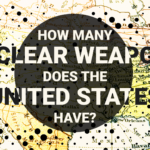Nuclear war, the black swan we can never see
By Seth Baum | November 21, 2014

Several centuries ago in England, the black swan was a popular symbol for the impossible because no such creature had ever been seen. Then came the surprise: Black swans were discovered in Australia. Since then, the bird has symbolized that which seems impossible but can in fact occur. The black swan reminds us that believing something cannot happen is often just a failure of imagination.
Parts of society today hold the same view of nuclear war that society in England did of black swans centuries ago: No nuclear war has ever been observed, so it may seem impossible that one would occur. Though nations possess some 16,000 nuclear warheads, deterrence just seems to work. And so, especially with the Cold War a fading memory, attention has shifted elsewhere. But it is just as much of a mistake to think that nuclear war couldn’t happen now as it was to think that black swans couldn’t exist back then.
It is true that, in any given year, nuclear war is unlikely, but the chance of it happening is not zero. Stanford professor emeritus Martin Hellman has a great way of explaining the risk. He compares it to a coin of unknown bias, flipped once a year for every year since the first Soviet nuclear weapon test in 1949. For 65 years, the coin has always landed on heads. If the coin had always landed flat on heads, we might think the probability of tails was close to zero. But in some years, the coin has teetered on its edge before falling on heads. Given this, should we still think the probability is near zero?
We have, after all, witnessed many teetering-on-the-edge moments. On October 27, 1962, during the Cuban missile crisis, the United States targeted the Soviet submarine B-59 with depth charges. Two out of three Soviet officers wanted to launch the submarine’s nuclear weapons in response, but launch procedures required agreement between all three. On January 25, 1995—after the Cold War—Russian radar detected the launch of a scientific weather rocket over the northern coast of Norway, and radar operators suspected it was a nuclear missile. Yeltsin and his associates decided not to launch a nuclear weapon in retaliation, correctly guessing that the rocket was not actually an attack. And from May to July of 1999, India and Pakistan fought a war over the Kargil district of Kashmir. Both countries already had nuclear weapons, which might have been used had the war escalated.
Calculating the odds. How does one go about estimating the annual probability of nuclear war—that is, the likelihood that it will occur during any one-year period? It is important to think in terms of probabilities per unit of time. The probability of nuclear war occurring next year is smaller than that of it occurring in the next decade. But the longer we wait, the more likely it is to occur. If the probability of nuclear war occurring in one year is, say, one in a thousand, then there will probably be a nuclear war within the next thousand years.
For certain kinds of events, one could figure out annual probabilities by looking back at history to see what portion of previous years had witnessed the events in question. But this doesn’t work for nuclear war. To take this backward-looking approach would be as though people in England hundreds of years ago had looked at their own historical experience to calculate what portion of swans were black.
To start calculating the odds, my colleagues and I studied one specific type of scenario: inadvertent nuclear war between Russia and the United States, in which one side mistakenly believes it is under attack and launches what it believes to be a counterattack but is actually a first strike. We found that the chance of such a war occurring during any given year is anywhere from about one-in-a-hundred to about one-in-a-hundred-thousand, depending on various assumptions. The total annual probability for all types of nuclear war will be larger than this, possibly much larger.
My colleagues and I estimated the probability of an inadvertent Russia-United States nuclear war by modeling the steps involved in going from a false alarm to a launch in response. When alarms are received, they are passed up the chain of command, receiving greater scrutiny at each step as officials decide whether the event in question poses a true threat. Only if the news reaches the top—in the United States that means the president—will weapons be launched in retaliation.
There is some publicly available historical data for how often false alarms have occurred and how far up the chain of command they’ve gone (other data is classified). We used as much historical data as we could find, but this still leaves a lot of uncertainty. We considered a variety of assumptions about how the uncertainty might be resolved, which is what gave us such a wide range of possible annual probability estimates. For example, it is unknown how often there are false alarms that could be perceived as nuclear attacks, so we considered a range of 43 per year to 255 per year based on data from 1977 to 1983. While there is no guarantee that the false alarm rate is still in that range (this information is classified), the range at least gives a sensible starting point.
Close calls. The fact that no nuclear war has ever happened does not prove that deterrence works, but rather that we have been lucky. What if the third officer on B-59 had felt differently about launching the submarine’s nuclear weapons? What if the Norwegian rocket incident had happened during a US-Russia crisis? What if India and Pakistan could not resolve the Kargil conflict so readily? Accidents happen. In 2013, during the brief period when the United States was threatening military intervention in Syria, Israel launched missiles from the Mediterranean towards its own coast to test its missile defense systems. Russian radar detected the launch. Israel cleared up the confusion before any damage was done, and no nuclear weapons are believed to have played any role in the incident. But it demonstrates the sorts of quirky perils we must still live with.
Likewise, looking around at current geopolitics, it should be clear that nuclear war is no less likely than it ever has been since the invention of the atomic bomb. Consider some of the states known to possess nuclear weapons: US-Russia relations may be worse now than they were in 1995, thanks to disagreements regarding Ukraine. India and Pakistan certainly have not resolved all their differences. China has its individual differences with India, Russia, and the United States. And Israel and North Korea are not exactly at peace with their neighbors.
While nuclear war is like a black swan, though, there is a critical difference between the two: Black swans don’t kill massive numbers of people. We can observe black swans and live to tell about it, but the same cannot necessarily be said of nuclear wars. Our continued existence may depend on the fact that one has never yet occurred. Nuclear war is the black swan we can never see, except in that brief moment when it is killing us. We delay eliminating the risk at our own peril. Now is the time to address the threat, because now we are still alive.
Together, we make the world safer.
The Bulletin elevates expert voices above the noise. But as an independent nonprofit organization, our operations depend on the support of readers like you. Help us continue to deliver quality journalism that holds leaders accountable. Your support of our work at any level is important. In return, we promise our coverage will be understandable, influential, vigilant, solution-oriented, and fair-minded. Together we can make a difference.
Topics: Columnists, Nuclear Weapons















